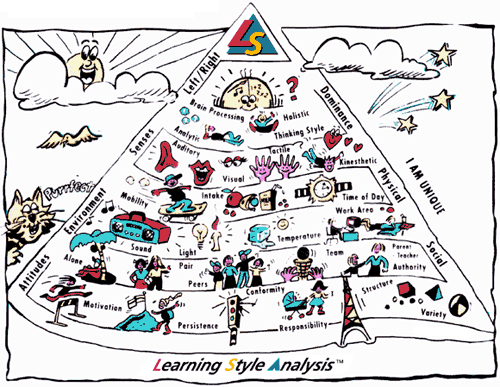
The LSA assesses 49 individual elements in the following six areas which are represented as layers of the pyramid. The first four of these layers can be described as biologically/genetically determined and the last two conditioned or learned:
- LEFT/RIGHT BRAIN DOMINANCE:
- showing sequential or simultaneous brain processing strategies,
- reflective or impulsive thinking styles, and
- overall analytic or holistic/global learning styles
- SENSORY MODALITIES:
- including auditory (hearing, talking, inner dialogue),
- visual (reading, seeing, visualising),
- tactile (manipulating, touching), and
- kinesthetic (doing, feeling) preferences
- PHYSICAL NEEDS:
- identifying needs for mobility (preferences for moving or being stationary),
- intake (eating, nibbling, drinking, chewing, etc), and
- time of day preferences (personal bio-rhythm)
- ENVIRONMENT:
- revealing preferences for sound (needing music/sound or wanting it quiet),
- light (needing bright or dim lighting),
- temperature (needing cool or warm), and
- work area (wanting formal or informal/comfortable design)
- SOCIAL GROUPINGS:
- including preferences for working alone, in a pair, with peers, or in a team,
- and authority (wanting to learn with a teacher or a parent)
- ATTITUDES:
- showing motivation (internally or externally motivated for learning),
- persistence (high, fluctuating, or low),
- conformity (conforming or non-conforming/rebellious),
- structure (being self-directed or needing directions, guidance from others),
- variety (needing routine or changes/variety)



 Compare Editions
Compare Editions